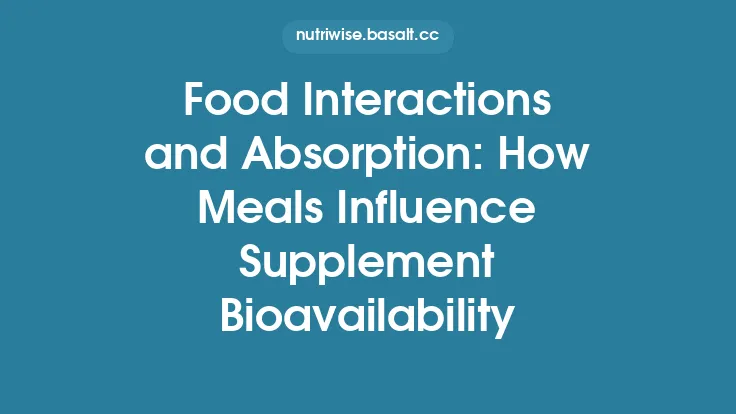Vitamin D is unique among micronutrients because its absorption hinges not only on the presence of the vitamin itself but also on the complex physical and chemical environment in which it is delivered to the gastrointestinal tract. While the skin can synthesize vitamin D3 (cholecalciferol) upon exposure to ultraviolet‑B radiation, most people obtain a substantial portion of their daily requirement from foods and fortified products. The “food matrix”—the intricate network of macronutrients, micronutrients, and structural components that make up a food item—plays a decisive role in determining how efficiently vitamin D is liberated from the food, incorporated into mixed micelles, and ultimately taken up by enterocytes. Understanding the interplay between vitamin D and its surrounding matrix is essential for nutrition scientists, dietitians, and food technologists who aim to design meals and products that maximize the vitamin’s bioavailability.
The Biochemical Pathway of Vitamin D Absorption
- Release from the Food Matrix
Vitamin D is a fat‑soluble compound that is often embedded within lipid droplets, protein‑bound complexes, or cellular membranes. The initial step of absorption requires physical disruption of these structures, which can be achieved through mechanical chewing, gastric churning, and enzymatic hydrolysis. The efficiency of this release is heavily influenced by the matrix’s composition—highly structured matrices (e.g., intact muscle fibers) may impede release, whereas emulsified or finely milled foods facilitate it.
- Emulsification and Micelle Formation
Once liberated, vitamin D must be solubilized in the aqueous environment of the small intestine. Bile salts, secreted in response to the presence of dietary fat, act as natural surfactants, forming mixed micelles that encapsulate vitamin D along with other lipophilic compounds. The size, composition, and stability of these micelles are critical; larger micelles may be less efficiently transported to the brush‑border membrane.
- Uptake by Enterocytes
The enterocyte membrane expresses several transport proteins that mediate the uptake of fat‑soluble vitamins, notably the scavenger receptor class B type I (SR‑BI) and Niemann‑Pick C1‑like 1 (NPC1L1). Vitamin D incorporated into micelles binds to these receptors, is internalized via clathrin‑mediated endocytosis, and subsequently transferred to intracellular lipid droplets or bound to intracellular binding proteins (e.g., cellular retinol‑binding protein, CRBP).
- Chylomicron Assembly and Lymphatic Transport
Inside the enterocyte, vitamin D is re‑esterified to its native form (if it had been hydrolyzed) and packaged into nascent chylomicrons. These lipoprotein particles enter the lymphatic system, bypass the hepatic portal circulation, and eventually deliver vitamin D to peripheral tissues after systemic circulation.
Each of these steps can be modulated by the surrounding food matrix, making the matrix a central determinant of overall bioavailability.
Lipid Content and Type: The Primary Drivers
Because vitamin D is lipophilic, the presence of dietary fat is the most potent enhancer of its absorption. However, not all fats are created equal:
- Long‑Chain Triglycerides (LCTs) – Typical of animal fats and many plant oils, LCTs provide a robust stimulus for bile secretion, leading to efficient micelle formation. Studies consistently show that meals containing ≥10 g of LCTs markedly improve vitamin D absorption compared with low‑fat meals.
- Medium‑Chain Triglycerides (MCTs) – Found in coconut oil and specialized MCT oil supplements, MCTs are rapidly hydrolyzed and absorbed directly into the portal vein. While they do stimulate bile release, the resulting micelles may be less stable for vitamin D incorporation, leading to modestly lower absorption rates than LCTs.
- Saturated vs. Unsaturated Fatty Acids – The degree of saturation influences micelle fluidity. Polyunsaturated fatty acids (PUFAs) tend to produce more fluid micelles, which can enhance the solubilization of vitamin D. Conversely, highly saturated fats may create more rigid micelles, potentially limiting vitamin D incorporation.
- Structured Lipid Systems – Emerging food technologies such as nano‑emulsions, liposomes, and solid lipid nanoparticles can mimic or improve upon natural lipid matrices. By reducing droplet size to the sub‑micron range, these systems dramatically increase the surface area available for bile interaction, thereby boosting micelle formation and vitamin D uptake.
Protein Interactions: Binding, Protection, and Competition
Proteins within the food matrix can both aid and hinder vitamin D absorption:
- Binding to Carrier Proteins
In animal-derived foods, vitamin D is often associated with specific binding proteins (e.g., vitamin D‑binding protein in egg yolk). These complexes can protect vitamin D from oxidative degradation during processing and storage. However, the protein‑vitamin complex must be dissociated during digestion for the vitamin to become available for micelle incorporation.
- Emulsifying Proteins
Milk proteins such as casein and whey possess natural emulsifying properties. When vitamin D is incorporated into dairy matrices, these proteins can stabilize fat droplets, facilitating more uniform micelle formation. Fermented dairy products, where casein micelles are partially broken down, may present a slightly altered matrix that can affect vitamin D release.
- Competitive Binding
Certain dietary proteins, especially those rich in hydrophobic amino acids, can compete with vitamin D for incorporation into micelles. While this competition is generally minor compared with the effect of fat, very high protein loads (e.g., protein‑shake meals with low fat) can modestly reduce vitamin D absorption.
Fiber and Non‑Lipid Carbohydrates: Indirect Modulators
Dietary fiber is often highlighted for its impact on mineral absorption, but it also influences vitamin D bioavailability through several mechanisms:
- Viscosity and Gastric Emptying
Soluble fibers (e.g., β‑glucan, pectin) increase the viscosity of the intestinal contents, slowing gastric emptying and potentially prolonging the time vitamin D spends in the absorptive zone. This extended exposure can be beneficial if sufficient bile is present, but excessive viscosity may impede micelle diffusion.
- Physical Entrapment
Insoluble fibers can physically entrap lipid droplets, reducing their accessibility to bile salts. In high‑fiber meals lacking adequate fat, vitamin D may become sequestered within fiber matrices, leading to reduced absorption.
- Fermentation Products
Colonic fermentation of fiber produces short‑chain fatty acids (SCFAs) that can stimulate bile acid synthesis. While the majority of vitamin D absorption occurs in the proximal small intestine, enhanced bile acid pools may indirectly support later-stage absorption of any residual vitamin D.
Overall, moderate fiber intake does not markedly diminish vitamin D absorption, but extremely high fiber, low‑fat meals can be suboptimal.
Food Processing and Structural Alterations
The way a food is processed can dramatically reshape its matrix, thereby influencing vitamin D bioavailability:
- Thermal Processing (Cooking, Pasteurization)
Heat can denature proteins and disrupt cellular membranes, liberating vitamin D from intracellular compartments. For example, cooking fatty fish (salmon, mackerel) improves vitamin D release compared with raw fillets. However, excessive heat may oxidize vitamin D, reducing its potency; thus, gentle cooking methods (steaming, low‑temperature baking) are preferred.
- Mechanical Disruption (Grinding, Homogenization)
Reducing particle size increases surface area, facilitating more efficient enzymatic hydrolysis and bile interaction. Ground meat, finely milled fish powders, and homogenized dairy products typically show higher vitamin D absorption than their coarse counterparts.
- Fortification Techniques
Vitamin D is commonly added to foods such as milk, orange juice, and breakfast cereals. The matrix in which the vitamin is incorporated matters: oil‑based emulsions used for fortifying low‑fat dairy provide a lipid environment that mimics natural food matrices, whereas water‑soluble powders may require additional emulsifiers to ensure proper micelle formation.
- Encapsulation Technologies
Microencapsulation of vitamin D in protective coatings (e.g., maltodextrin, whey protein isolate) can shield the vitamin from light and oxygen during storage. Upon ingestion, the coating dissolves in the gastrointestinal tract, releasing vitamin D into a lipid‑rich microenvironment that promotes absorption.
Inter‑Individual Variability: Genetic and Physiological Considerations
Even with an optimal food matrix, absorption efficiency can vary among individuals:
- Genetic Polymorphisms
Variants in genes encoding SR‑BI, NPC1L1, and the vitamin D‑binding protein (GC gene) have been linked to differences in plasma vitamin D concentrations after standardized meals. While these genetic factors are beyond the control of food formulation, understanding them can guide personalized nutrition strategies.
- Age‑Related Changes
Elderly individuals often exhibit reduced bile acid secretion and pancreatic lipase activity, which can diminish micelle formation. Consequently, meals designed for older adults may benefit from higher fat content or the inclusion of pre‑emulsified vitamin D to compensate for reduced digestive efficiency.
- Health Status
Conditions that impair fat digestion (e.g., pancreatic insufficiency, cholestasis) directly affect vitamin D absorption. In such cases, supplementation with water‑soluble vitamin D analogs or high‑dose fortified emulsions may be necessary.
Practical Recommendations for Maximizing Vitamin D Absorption
- Pair Vitamin D‑Rich Foods with Adequate Fat
Aim for at least 10 g of dietary fat per serving of vitamin D‑containing food. Good pairings include salmon with olive oil, fortified milk with a handful of nuts, or egg yolk incorporated into a butter‑based sauce.
- Choose Fat Types that Support Micelle Stability
Incorporate a mix of monounsaturated (olive oil, avocado) and polyunsaturated fats (walnut oil, flaxseed oil) to promote fluid micelle formation. Limit reliance on exclusively saturated fats if the meal is low in overall fat.
- Utilize Processed Forms that Enhance Release
Opt for cooked or mechanically processed vitamin D sources (e.g., baked fish, ground meat, fortified smoothies) rather than raw, intact tissues when possible.
- Consider Advanced Delivery Systems
For individuals with compromised fat digestion, select products that employ nano‑emulsions or liposomal vitamin D, which bypass some of the traditional digestive steps.
- Mind the Timing of High‑Fiber Meals
If a meal is exceptionally high in fiber, ensure it also contains sufficient fat, or separate the fiber‑dense component (e.g., a high‑fiber salad) from the vitamin D source by 30–60 minutes to reduce physical entrapment.
- Store Fortified Products Properly
Vitamin D is sensitive to light and oxidation. Keep fortified milks, juices, and powders in opaque containers and avoid prolonged exposure to high temperatures to preserve potency.
Future Directions in Food Matrix Research
The field of nutrient bioavailability is rapidly evolving, and several promising avenues are emerging for vitamin D:
- Personalized Matrix Design
Leveraging data from genomics and metabolomics, researchers aim to tailor food matrices that align with an individual’s digestive capacity and genetic profile, optimizing vitamin D uptake on a personalized basis.
- Synergistic Micronutrient Formulations
While the present article focuses on vitamin D alone, there is growing interest in co‑encapsulating vitamin D with other fat‑soluble nutrients (e.g., vitamin K2, omega‑3 fatty acids) to create synergistic matrices that enhance the absorption of all components.
- In‑Vitro Digestion Models Coupled with Imaging
Advanced simulated gastrointestinal systems combined with confocal microscopy are allowing scientists to visualize the real‑time release of vitamin D from complex matrices, providing unprecedented insight into the mechanistic steps that govern absorption.
- Sustainable Food Sources
As the demand for plant‑based vitamin D rises, research is exploring algal oils, mushroom‑derived vitamin D2, and fortified plant milks. Understanding how these novel matrices interact with human digestion will be crucial for ensuring their efficacy.
Concluding Perspective
Vitamin D absorption is a multifaceted process that transcends the simple presence of the vitamin in a food item. The surrounding matrix—comprising lipids, proteins, carbohydrates, and structural elements—dictates how efficiently the vitamin is liberated, solubilized, and transported across the intestinal wall. By appreciating the roles of fat type and quantity, protein interactions, fiber content, and processing methods, nutrition professionals can design meals and products that consistently deliver optimal vitamin D bioavailability. As research continues to unravel the nuances of the food matrix, the potential to fine‑tune dietary strategies for diverse populations—ranging from infants to the elderly—will become increasingly attainable, supporting public health goals of adequate vitamin D status worldwide.





